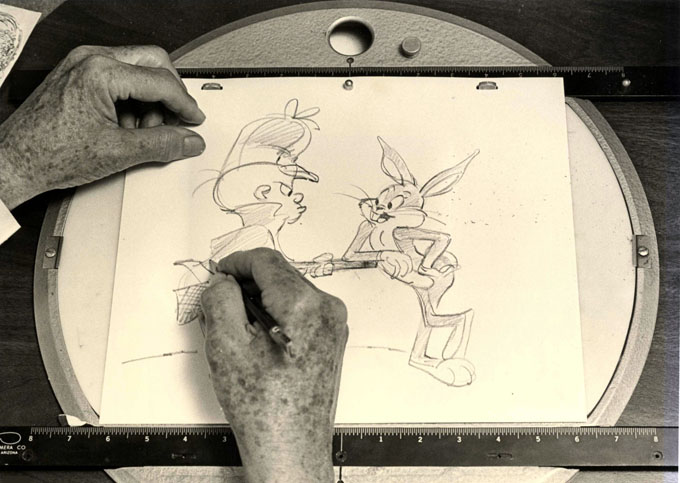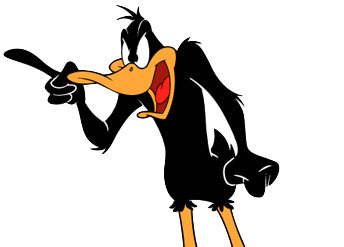By providing your information, you agree to our Terms of Use and our Privacy Policy. We use vendors that may also process your information to help provide our services. This site is protected by reCAPTCHA Enterprise and the Google Privacy Policy and Terms of Service apply.
Why Chuck Jones Was More Than Just a Great Animator
Eric Kohn

If you believe that the cartoons you enjoyed as a child don’t warrant serious consideration as art, think again. The Road Runner moves so swiftly away from the clutches of Wile E. Coyote that it’s easy to forget that both characters started as line drawings. But anyone versed in the classic Road Runner cartoons, not to mention the exploits of Bugs Bunny and Daffy Duck, should embrace the opportunity to explore the creativity responsible for their existence.
That chance arrives with “What’s Up Doc? The Animation Art of Chuck Jones,” a new exhibit opening at the Museum of the Moving Image this Saturday, commissioned by the Smithsonian Institution. After completing its run in January at the Queens museum, the exhibit will travel around the country, providing a new opportunity to evaluate Jones’ artistry more than a decade after his death.
The exhibit provides a fascinating window into Jones’ process, including 125 sketches and drawings in addition to audio recordings of his studio sessions and screenings of 23 shorts. The resulting showcase illustrates Jones’ capacity to create pop art with a sensibility that transcended its commercial roots.
Notably, the animator won an Oscar not for his Warner Bros. cartoons but for a more abstract effort called “The Dot and the Line,” and as the exhibit proves, his sophisticated understanding of visual storytelling continues to have an impact on Pixar films today.
During a press preview for the exhibit earlier in the week, Indiewire sat down with the exhibit’s curators, Barbara Miller and David Schwartz, to discuss Jones’ lasting relevance and how it’s addressed in the exhibit.
The Genius of the Pencil
 DAVID SCHWARTZ: There’s great material from “What’s Opera, Doc?” and great background paintings from the Road Runner cartoons. What’s surprising to me is that there’s not a lot of cels. When you think of the material of the production of animation, you think of cel paintings, but a lot of those aren’t around. A lot of them were just discarded. Luckily, Chuck kept a lot of his own drawings — and they’re really just simple pencil drawings. He did a lot. He really worked out the cartoons frame by frame, using exposures — basically charts to break down the cartoons into individual frames. He created those and then did these layout drawings that would have the key poses of the characters.
DAVID SCHWARTZ: There’s great material from “What’s Opera, Doc?” and great background paintings from the Road Runner cartoons. What’s surprising to me is that there’s not a lot of cels. When you think of the material of the production of animation, you think of cel paintings, but a lot of those aren’t around. A lot of them were just discarded. Luckily, Chuck kept a lot of his own drawings — and they’re really just simple pencil drawings. He did a lot. He really worked out the cartoons frame by frame, using exposures — basically charts to break down the cartoons into individual frames. He created those and then did these layout drawings that would have the key poses of the characters.
I think what surprised me is that a lot of the pencil drawings that Chuck made, you feel the movement in them. I mean, he really shows how the characters move. There’s just something about the way he draws where he’s able to capture a kinetic sense. That was the biggest surprise — to see the cartoons come to life on a piece of paper with these simple drawings he did. What’s new here is that the exhibition really shows the process, how you get from Jones’ drawings to the finished cartoons.
BARBARA MILLER: There’s an appreciation not just for the cartoons but the collaborations, the methods — all the different steps that it takes to do something like this. No matter what kind of tools Jones and his colleagues used, what’s more important is his approach to character animation. It’s about really infusing animated characters with something human and to define that character through the way it moves. That was really what the Warner animators, and Chuck Jones in particular, were all about.
Animating For Adults
 SCHWARTZ: We really make it clear to people that these are films made to be shown on Saturday nights so we have a lobby card and posters, to make the point that these were films shown in movie theaters, basically for adults. You never get the sense that Chuck was making these films for kids. That was also true of Jim Henson. He had to be really pushed to do “Sesame Street.” The more you hear Chuck talk, the more you realize that he didn’t talk down to his audience. He was always making references to literature and classical music.
SCHWARTZ: We really make it clear to people that these are films made to be shown on Saturday nights so we have a lobby card and posters, to make the point that these were films shown in movie theaters, basically for adults. You never get the sense that Chuck was making these films for kids. That was also true of Jim Henson. He had to be really pushed to do “Sesame Street.” The more you hear Chuck talk, the more you realize that he didn’t talk down to his audience. He was always making references to literature and classical music.
There are some drawings from Road Runner cartoons where it’s so pared down. To me, that’s the height of his artistry. In some instances, it basically is just a dot and a line, just like “The Dot and the Line.” We showed that in the drawings. He’ll do these very pared down drawings and you’ll see how it’s translated into the cartoon, the way he distills everything into its simplest terms. With Chuck, he didn’t go for zany gags like, say, Tex Avery did. He had a somewhat different style.
Chuck really felt like every moment had to be believable, that every character had to be believable. He wouldn’t just go for a cheap laugh.
MILLER: Whether or it’s a dot or Bugs Bunny, the same principles apply, where whatever he’s animating has to have an internal consistency to it that doesn’t just relate to the joke in the scene. There’s a believability that extends throughout the history of that character.
From Jones to Lasseter
 MILLER: This exhibition is meant to ask what makes an animation director — and Chuck Jones such a great example of one. That was their job, to control all of that.
MILLER: This exhibition is meant to ask what makes an animation director — and Chuck Jones such a great example of one. That was their job, to control all of that.
SCHWARTZ: It’s interesting that John Lasseter is such a presence in the exhibition. When any great animator would say is that it’s not the tools that make the cartoon, it’s the personality, the story. So you see that Chuck Jones’ influence is very strong on Pixar — and the Road Runner cartoons are essential to the “Ice Age” series. They have the same simplicity of geometry, the humor, so you feel Jones’ influence a lot, even though the tools he used were very different.
MILLER: I think Chuck would probably say that a lot of contemporary animation is extracting humor, which is great, but that the character animation is not so unique. He said you should be able to turn the sound off and know what was going on. Why do animation if all you’re doing could be done with live action?
An Indie at the Studio
 SCHWARTZ: He felt that he was working independently even within Warner Bros. In his mind, the executives there were all a bunch of idiots. It helped him to think of [Warner Bros. executive] Leon Schlesinger and all those people as a bunch of idiots. He figured he was making cartoons they’d want to see. They definitely had that sensibility of being part of an indie studio. The executives just wanted seven minutes of screen time on a 5 week schedule. It was so cut and dry to them that they didn’t even really pay attention to what was on the screen.
SCHWARTZ: He felt that he was working independently even within Warner Bros. In his mind, the executives there were all a bunch of idiots. It helped him to think of [Warner Bros. executive] Leon Schlesinger and all those people as a bunch of idiots. He figured he was making cartoons they’d want to see. They definitely had that sensibility of being part of an indie studio. The executives just wanted seven minutes of screen time on a 5 week schedule. It was so cut and dry to them that they didn’t even really pay attention to what was on the screen.
MILLER: What’s really important to know is that, as far as Warner Bros. were concerned, these things were completely ephemeral. They spent very little money on them; they were meant to be shown before the feature. The end. It wasn’t some big showcase for amazing talent for them. There wasn’t this sense that art was being made. They were making these throwaway cartoons they could show in their theaters.
SCHWARTZ: Daffy Duck’s voice was based on Schlesinger, who didn’t even realize it. He talked like that.
MILLER: They’d say things like, “There’s nothing funny about bullfights. Don’t make a cartoon about bullfighting.” And they did anyway.
By providing your information, you agree to our Terms of Use and our Privacy Policy. We use vendors that may also process your information to help provide our services. This site is protected by reCAPTCHA Enterprise and the Google Privacy Policy and Terms of Service apply.
















